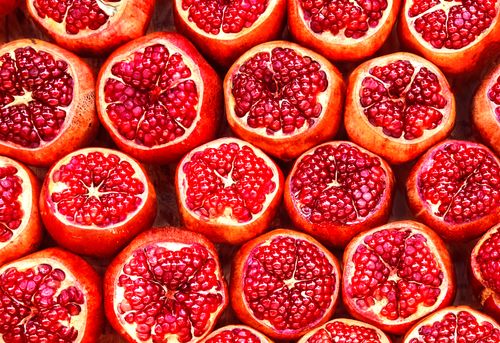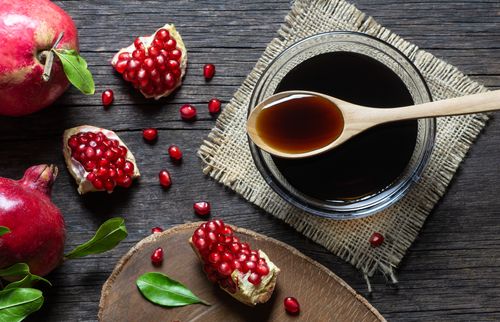Pomegranate: Health Benefits, Uses, and More HealthifyMe Blog HealthifyMe Blog - The definitive guide to weight loss, fitness and living a healthier life.
The pomegranate fruit comes from a deciduous shrub. Its botanical name is Punica Granatum. These shrubs mainly grow in the Middle East, Indian subcontinent, North Africa, and the Mediterranean. Pomegranate comes under the classification of berries and has a flower-shaped stem. Its bright red color and tart taste are some of its attractive features. The pH of a pomegranate is about 4.4 which explains its sweet and sour taste.
Physical Structure of a Pomegranate
The pomegranate shrub is grown for ornamental purposes as well as for the fruit. The flowers of the plant are bright red too. The structure of a pomegranate is unlike other fruits with flesh and a core. The outermost red layer is a hard and inedible shell. The edible part of the fruit is the seeds and arils.
Arils are the sweet, juicy, and crunchy covering of seeds. A white spongy layer acts as bedding for these arils and covers the remaining space. The seed count varies from 200 to 1400 depending on the pomegranate. The aril juice has a red pigmentation that can stain clothes. This is mainly due to the presence of anthocyanins and ellagitannins in the fruit.
Pomegranate: Usages
The Ayurveda medicinal system talks highly of pomegranates as a home remedy. Its culinary uses are immense. Its flavor goes well with baking, syrups, food garnishes, and cold beverages. The dried seeds are a form of spice in Indian and Pakistani cuisine. Turkish cuisine uses pomegranates for marinating meat and dressing salads. Middle Eastern countries use fruit juice as a glaze for lamb kebabs.
Apart from its modern-day uses, pomegranate finds its importance in symbolism and art. Many ancient motifs depict pomegranates on mosaics and walls. The fruit is often synonymous with prosperity, ambition, and fertility.
Nutritional Facts of Pomegranate
100 grams of pomegranate arils contains the following nutrients.
- Calories: 83 kcal
- Carbohydrates: 18.7 g
- Sugar: 13.67 g
- Fibre: 4 g
- Protein: 1.67 g
- Fat: 1.17 g
- 78% of pomegranate’s composition is water. It has around 19 g of carbs of which dietary fibre contributes 4 g. The fibre content is intact in the seeds and makes up for 20% of the daily value. It has a decent 83 calories for a 10-gram serving.
- Pomegranates have abundant phytochemicals like polyphenols. Processing and pasteurizing the fruit reduces its phenolic activity.
- Pomegranates are rich in ellagitannins, also known as punicalagin. They are powerful antioxidants that make the fruit stand out in front of the rest. Pomegranate contains three times more antioxidants than green tea and red wine.
- Pomegranate peel extracts are important dietary supplements and preservatives. They contain large amounts of polyphenols, catechins, and condensed tannins.
- The seeds of the fruit give an oil that is rich in punicic acid. It is a type of good fat that makes up about 65% of the oil’s composition. These fats have multiple health benefits.
- High amounts of vitamin K, C, and folate (B9) contribute to its vitamin profile. Vitamin K makes up 16% of daily value and vitamin C for 12%. A significant amount of vitamin E, riboflavin, thiamine, and pantothenic acid are also present.
- The mineral content of pomegranates is rich in manganese, phosphorus, potassium, and zinc. Smaller traces of iron and calcium make it to the list too.
10 Health Benefits of Pomegranate
1. Lowers blood pressure
A study shows that the regular consumption of pomegranate juice reduces hypertension. It is especially known to regulate systolic blood pressure.
2. Cancer preventing properties
The preliminary results of some studies show that pomegranate can reduce the growth of cancer cells. Its properties inhibit prostate and breast cancer cells from increasing. While there is no major study with proof yet, there is no loss in consuming pomegranates.
3. Contains anti-inflammatory properties
Chronic inflammation can lead to heart disease, diabetes, and obesity. Punicalagin in pomegranates is a powerful antioxidant. All antioxidants have potent anti-inflammatory properties. According to a study, these help to reduce inflammation in the digestive tract in specific.
4. Helps with arthritis
Swelling of joints is common in those who suffer from arthritis. The anti-inflammatory properties of pomegranates help to calm down any inflammation. Studies also show that pomegranates are successful in inhibiting enzymes that cause damage to joints. This can help treat osteoarthritis effectively.
5. Promotes healthy heart functioning
Pomegranates are one of the top heart-friendly fruits. The good fat component of pomegranate goes by the name of punicic acid. It helps to protect the heart from several steps of heart disease. Pomegranates reduce high blood pressure, which can be one of the major contributors to heart ailments.
6. Lowers cholesterol
Certain studies prove that pomegranate reduces the level of bad cholesterol in the body. It also says that it protects this cholesterol from oxidizing. This is crucial as the oxidation step is one of the main reasons for heart diseases.
7. Fights bacterial and fungal infections
According to a study, pomegranate can fight certain types of harmful bacteria and yeast by the name Candida albicans. The powerful plant compounds in pomegranates can combat dangerous microorganisms. These properties may prevent oral infections like gingivitis and denture stomatitis.
8. May cure erectile dysfunction
Pomegranate increases blood flow throughout the body. A study done on rabbits shows an increase in erectile response after consuming pomegranates. Its effect on humans is lower in statistics.
9. Enhances memory
There are some proofs to link pomegranate with enhancing memory power. Regular consumption of the fruit reduces the post-surgery deficit in memory. Older adults with memory issues can drink pomegranate juice regularly. A study done with similar adults shows an improvement in their visual and verbal memory.
10. Increases physical performance
Similar to beetroots, pomegranates promote better physical performance. It helps delay fatigue after exercising. Studying a group of athlete’s efficiency post-workout elucidated this effect of pomegranate. Consuming a gram of pomegranate extract showed a significant increase in their exercise efficiency.
Ways to Consume Pomegranate
A simple and healthy way of including pomegranate is to eat it raw. Pomegranate arils taste great on their own. Removing them from its outer layer may get tricky. Cut the fruit in half. Hold a piece over a bowl such that the arils are facing the bowl. Tap the fruit firmly a couple of times till the arils drop into the bowl. Another effective method is to score the fruit with a knife.
- Add pomegranates to salads. The crunchy and sweet arils give an interesting twist in taste. Pair it up with feta cheese, veggies, and nuts. You can also add them to fruit salads for a healthy dessert option.
- It serves as a dessert garnish. Top yogurt and parfait with some pomegranate arils for a boost of flavor. It goes well as an ice cream topping too.
- Pomegranate juice is a highly popular way of consuming fruit. Those who do not prefer the seed taste can grind it into a juice. Add some milk to get a smoothie type of consistency. Always opt for a fresh pomegranate juice. The processed version reduces its nutritional value.
- Make a dipping sauce out of it. Reduce pomegranate juice on heat and add some spices and extra sugar. The thickened sauce serves a dip for meat and shrimp.
- The juice finds its use as a marinade as well. The sweet and sour taste of pomegranate enhances the flavor of meats.
- Start your mornings with a cup of oatmeal or cereal topped with pomegranate arils. The combination of soft oats and crunchy arils is delicious.
- Use pomegranates as a topping on pizzas. It gives a unique flavor to it.
Summary
Pomegranates are a super fruit. It is water-based and contains minimal calories. The peels and the edible part called arils are rich in nutrients and plant compounds. It is a popular fruit in Ayurveda medicines. Pomegranates also find their significance through ancient art and symbolism.
Consuming pomegranates regularly can cure many diseases. Cholesterol, high blood pressure, obesity and heart ailments are some of them. Some studies say that pomegranates have the power to reduce cancer cells. However, more scientific proofs are necessary to support this claim. The reason for its many benefits are two of its special components; Punicalagins and punicic acid. Punicalagins are powerful antioxidants and the latter is a form of good fat.
Its sweet and slightly sour taste combines well with salads and meat. It acts as a flavourful topping that goes well with almost every food item. Moreover, its memory-enhancing quality and anti-inflammatory properties make it an optimal addition to your diet. Eat pomegranate arils raw or drink its natural juice to obtains its many benefits.
Frequently Asked Questions (FAQs)
A. Pomegranates have many qualities that make them a good choice of fruit for weight loss. 100 grams of arils contains only 83 calories. These limited amounts of calories will help to keep your daily calorie limit in control. Its high fibre content keeps you full for a longer time. This prevents overeating. The polyphenols in pomegranates have links with being natural fat burners. Overall, incorporating pomegranates into your diet will aid in losing weight.
A. Pomegranates are one of the best fruits for increasing blood count. It is packed with nutrients like iron, vitamin A, C, and E. Pomegranates contain ascorbic acid. This acid further promotes iron content in the body. It increases the hemoglobin level significantly. Consume pomegranate juice every day to see optimum benefits.
A. Pomegranates are rich in vitamin C. This vitamin combats many skin issues like roughness, pigmentation, and dullness. Its anti-inflammatory properties help to cure acne and zits. Pomegranates fight fungal or bacterial infections on the skin due to their antibacterial and antifungal properties. It protects the skin from sun damage that can lead to various skin disorders. The antioxidants in pomegranates prevent cells from oxidative damage.
A. Pomegranates are known to increase insulin sensitivity. Its rich antioxidant content can cure chronic illnesses like diabetes. Regular consumption of pomegranates reduces the bad cholesterol in diabetic patients. Its low carbohydrate content will ensure a sudden spike in blood sugars does not occur. Hence, pomegranates are safe and beneficial for diabetic patients.
A. Drinking pomegranate juice on an empty stomach is completely safe. It is a water-based fruit that also contains electrolytes. Hence pomegranate juice can hydrate your body first thing in the morning. Many of its nutrients and health benefits are best absorbed on an empty stomach. Ideally, drinking pomegranate juice on an empty stomach is better than any other time of the day.
The post Pomegranate: Health Benefits, Uses, and More appeared first on HealthifyMe Blog.
from HealthifyMe Blog https://ift.tt/3C0ZqcA


Post a Comment
Post a Comment